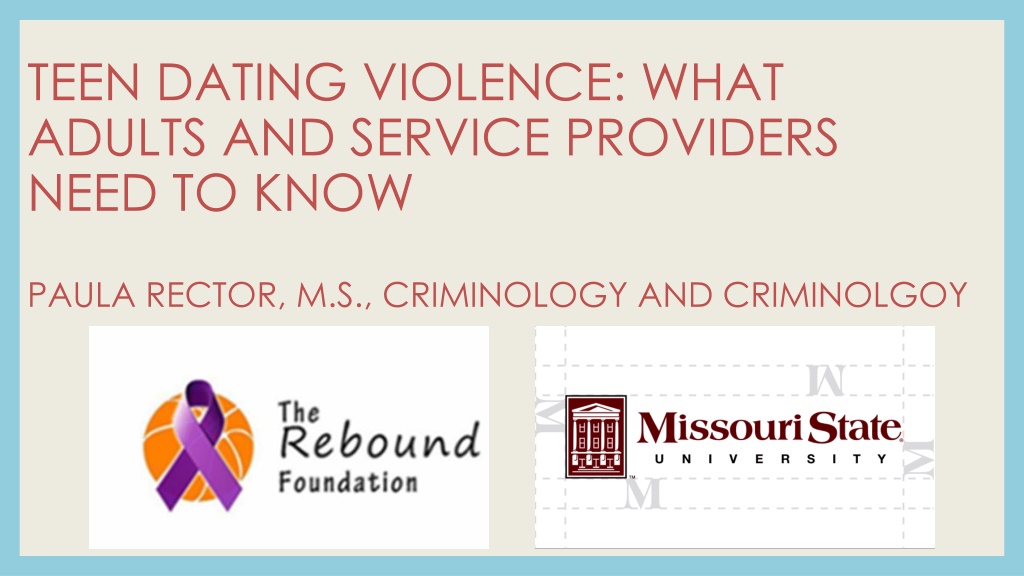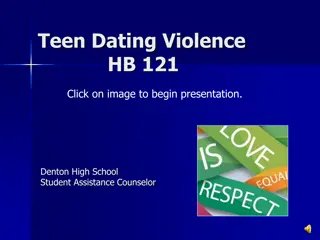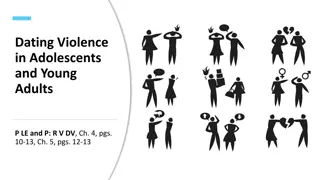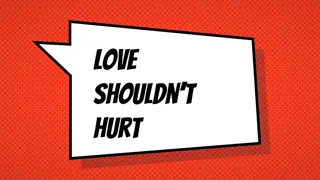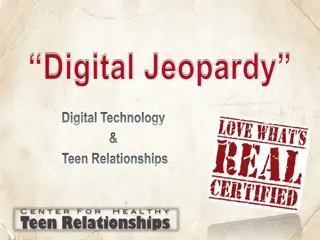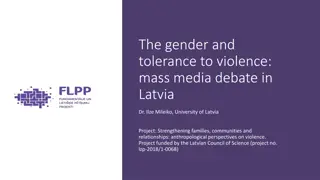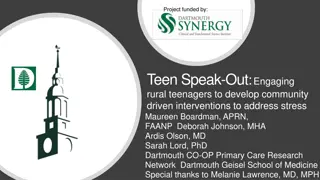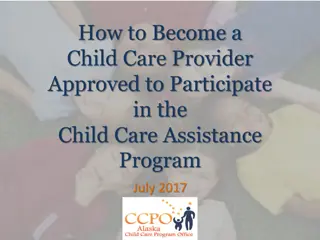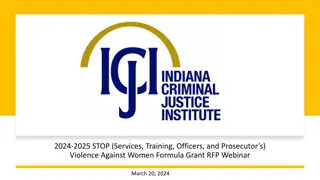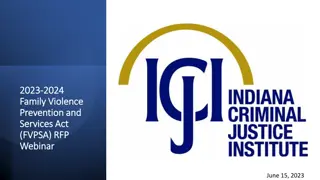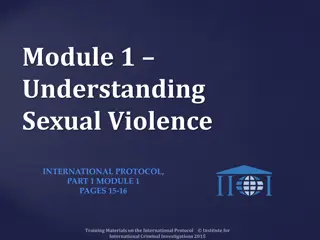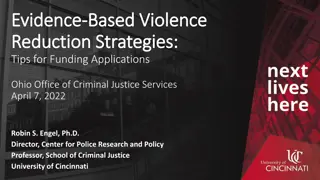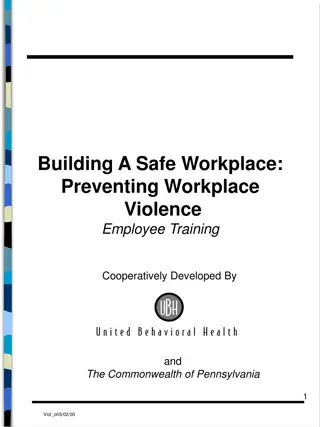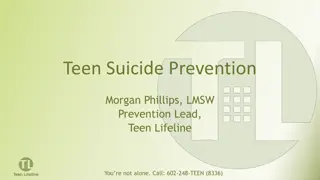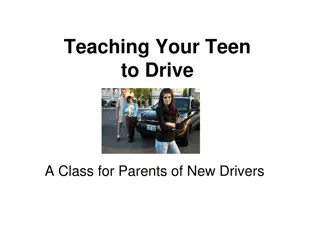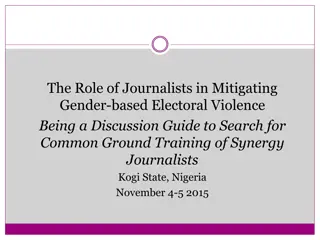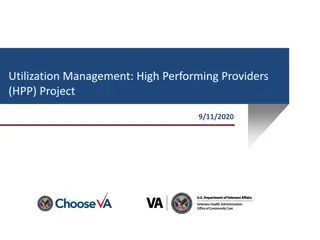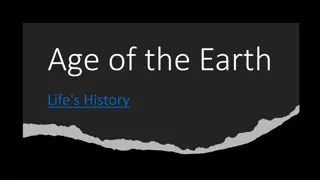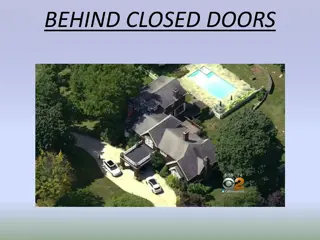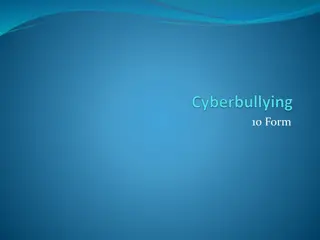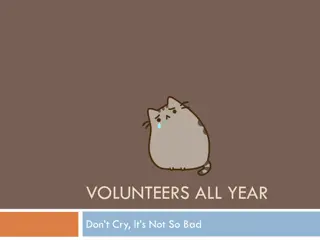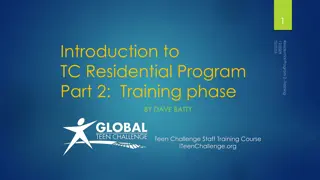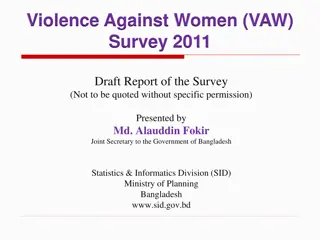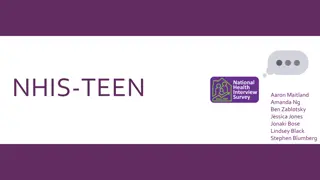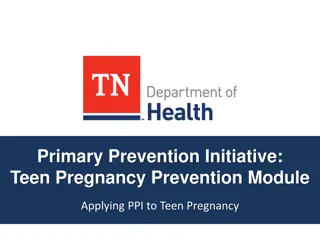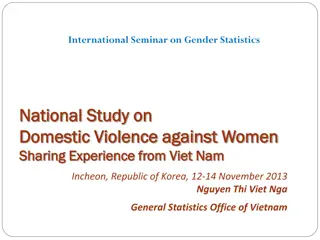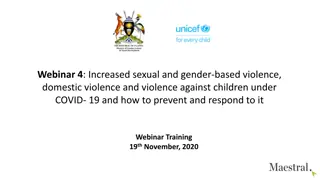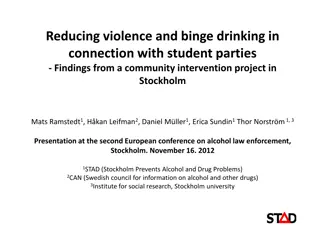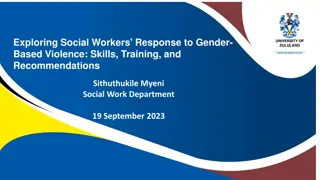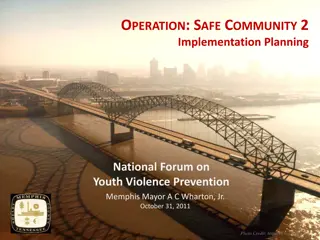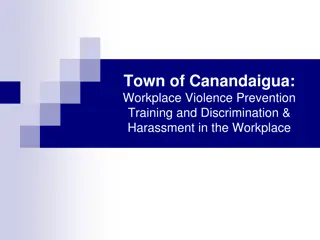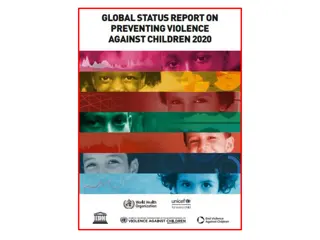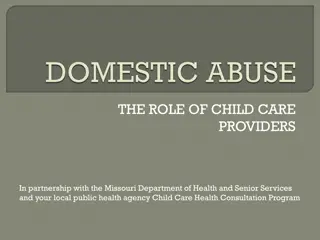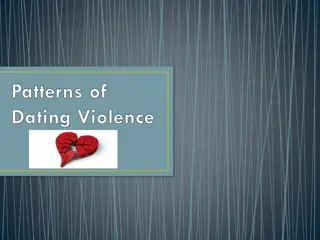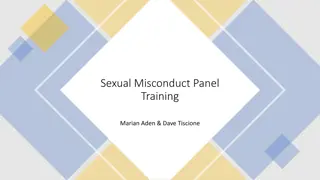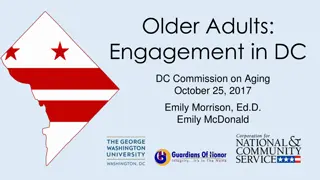Understanding Teen Dating Violence: A Guide for Adults and Service Providers
Teen dating violence is a prevalent issue impacting millions of young people in the United States. This guide covers the plan to address unhealthy behaviors, statistics, impacts, talking to young people about the issue, being a resource, helping friends in unhealthy relationships, and available resources. It emphasizes the importance of preventing violence and fostering violence-free growth for young individuals.
Download Presentation

Please find below an Image/Link to download the presentation.
The content on the website is provided AS IS for your information and personal use only. It may not be sold, licensed, or shared on other websites without obtaining consent from the author. Download presentation by click this link. If you encounter any issues during the download, it is possible that the publisher has removed the file from their server.
E N D
Presentation Transcript
TEEN DATING VIOLENCE: WHAT ADULTS AND SERVICE PROVIDERS NEED TO KNOW PAULA RECTOR, M.S., CRIMINOLOGY AND CRIMINOLGOY
What is the plan??? What do unhealthy behaviors look like? What do statistics tell us? What is the impact of teen dating violence? How can I talk to young people about this issue before they start dating? How can you be a resource to young people in relationships? How can a young person help a friend who may be in an unhealthy relationship? Resources
How do young people learn about relationships?? And What are they learning??
Teen dating violence is an adverse childhood experience that affects millions of young people in the United States.
Teen dating violence profoundly impacts lifelong health, opportunity, and wellbeing. Unhealthy relationships can start early and last a lifetime. The good news is violence is preventable, and we can all help young people grow up violence-free.
Relationship Abuse Facts 1 in 2 1 in 4 men 1 in 3 women trans & nonbinary people Will be in an abusive relationship during their lifetime. *Sources: CDC, Safe Horizon, Corporate Alliance to End Domestic Violence
One in three adolescents in the U.S. is a victim of physical, sexual, emotional or verbal abuse from a dating partner, a figure that far exceeds rates of other types of youth violence. What do statistics tell us? Every year, nearly 1.5 million high school students are physically abused by their partner.
WHO IS AT RISK???? Rates of physical and sexual dating violence compared to students who identified as heterosexual. Some teens are at greater risk than others. Female students experienced higher rates of physical and sexual dating violence than male students. Girls and young women between the ages of 16 and 24 experience the highest rate of intimate partner violence almost triple the national average. Students who identified as lesbian, gay, bisexual, transgender, or queer (LGBTQ) or those who were unsure of their gender identity experienced higher
Risk Factors for Victimization History of physical, sexual, emotional, or verbal abuse History of alcohol or drug use by either partner Prior injury from a dating partner Witnessing violence in the home Childhood abuse
Risk Factors for Perpetration Knowing friends who were involved in dating violence Witnessing violence in the home Having experienced trauma Engagement in peer violence Believing that dating violence is acceptable Using alcohol or drugs Childhood abuse
GENDER SIMILARITIES AND DIFFERENCES Studies focused on the rates of teen dating violence by gender have had inconsistent results. The question is .WHAT IS BEING MEASURERED VARIES BY TYPE OF VIOLENCE
Girls disproportionately experience severe violence in relationships Seriously injured Use of weapon Sexual abuse Reproductive manipulation
Motivations Both boys and girls report anger as the prime cause of their aggressive acts Girls are more likely to report self-defense as a motivator for aggression Boys are more likely to report the desire for control
Boys Rarely report physical harm More likely to laugh off aggressive acts by their partner Girls Outcomes Report serious harm and physical injury More likely to suffer long-term negative consequences such as suicide attempts, depression, and substance use.
LGBTQ RELATIONSHIP VIOLENCE: SIMILARITIES AND DIFFERENCES Rates of violence and abuse are higher for teens in same-sex relationships Types of unhealthy behaviors and types of violence are similar Stereotypes of relationships impact response Reporting rates Females are more likely to report victimization than males
WHAT IS THE IMPACT? Unhealthy, abusive, or violent relationships can have short-and long-term negative effects, including severe consequences, on a developing teen. Depression and anxiety symptoms Engage in unhealthy behaviors, like using tobacco, drugs, and alcohol Exhibit antisocial behaviors, like lying, theft, bullying, or hitting
Conflict with peers Eating disorders Poor school performance and more absences Pregnancy and STI s Suicidal ideations and attempts
Violence in an adolescent relationship sets the stage for future relationship problems, including intimate partner violence and sexual violence perpetration and/or victimization throughout life.
Lack of Help Teens more likely than adults to keep dating violence a secret, why??? Majority of teen victims never obtain mental health services, seek protection in shelters, or pursue legal help, such as cases against abusers and protection orders. Exacerbated for male survivors, who are more than two times less likely than girls to seek help and/or report. When teens do seek help regarding dating violence victimization, they typically turn to peers rather than turning to adults or going through a formal reporting process.
SO.WHAT CAN ADULTS DO????
START THE CONVERSATION!!!!
10 Signs Discussion These 10 behaviors are often used as a way to gain power or control over a partner UNHEALTHY SIGNS Deflecting responsibility Possessiveness Manipulation Betrayal Sabotage Intensity Belittling Guilting Isolation Volatility If ignored, can lead to an abusive relationship Abuse is the intentional attempt to control and/or have power over your partner, consciously or subconsciously, that negatively impacts their day to day life
How can I talk to young people about this issue before they start dating? Talk to them about healthy friendships before they start dating Use teachable moments in the media Remember that young people are watching adults in their lives and their relationship behaviors Let them know that unhealthy and/or abusive behaviors can happen to anyone, including friends What are some things you might say to start this conversation?
How can you be a resource to young people in relationships? Have conversations about what healthy relationships look like. Weave conversations about unhealthy relationships into conversations about other relevant topics, like alcohol use and social media. Talk about consent! Recognize your own perceptions and biases about relationships. Reinforce that emotional abuse is abuse, too! What are some things you might say to start this conversation?
How can a young person help a friend who may be in an unhealthy relationship? Use teachable moments and role play specific strategies for intervening when they see disrespectful behavior Help young people identify other important adults in their lives they can go to if they are worried about a friend's relationship or their own Talk to young boys about their role in preventing abuse and be open to discussing social norms that may prevent youth from thinking they can be an upstander What are some things you might say to start this conversation?
What if my friend is experiencing relationship violence? Start the conversation on a calm and positive note by being friendly, not preachy. Focus on the unhealthy behaviors you ve seen rather than on their partner. Don t place blame on your friend and try to help them understand what they are experiencing isn t normal and isn t their fault. Give your friend a list of options and empower them to make their own decisions on what to do next and expect more conversations in the future Direct Delegate Distract Delay
How can I help a young person who might be in an unhealthy relationship or is exhibiting unhealthy behaviors? Believe what they are telling you and know that they might not tell you everything right away. Validate their feelings and their timeline. Focus on the abusive behaviors rather than the person. If you see a young person exhibiting abusive behavior, encourage them to seek professional help. Understand the dangers of a breakup. In a young persons relationship is unhealthy, make sure they have a say in what happens next. Slowly move towards solutions that feel right to them. Listen to your gut feeling about how a young person is acting. Ask them if everything is alright. A young person may be afraid to tell you what is going on. What are some conversations starters when you are worried about a child's relationship?
Screening for Violence Ask every client. Understand the risk factors. Screen electronically. Show genuine concern. Be prepared to share resources.
Resources The Rebound Foundation: 417-860-4599 LOVE IS RESPECT www.LoveIsRespect.org | 1-866-331-9474 or 1-866-331-8453 | text loveis to 22522 THE TREVOR PROJECT www.thetrevorproject.org/ | 1-866-488-7386 The Trevor Project is the leading national organization providing crisis intervention and suicide prevention services to lesbian, gay, bisexual, transgender and questioning (LGBTQ) young people. ONE LOVE MYPLAN APP (can be found in the app store http://bit.ly/1bJsRll) This app is a safety decision aid for survivors of relationship violence, and it helps to determine if a relationship is unsafe. It helps create the best action plan by weighing an individual's unique characteristics and values.
FEBRUARY IS TEEN DATING VIOLENCE AWARENSS MONTH!!!!
THANK YOU! PAULA RECTOR MISSOURI STATE UNIVERSITY PAULARECTOR@MISSOURISTATE.EDU THE REBOUND FOUNDATION WWW.THEREBOUNDFOUND.ORG
